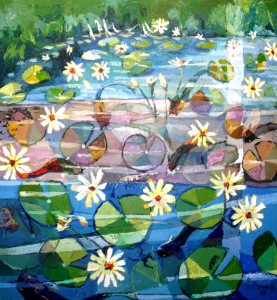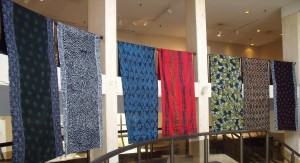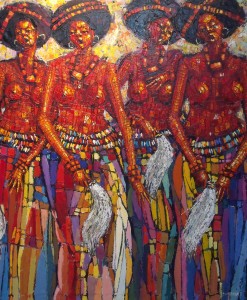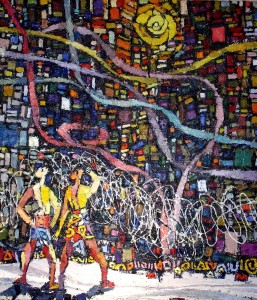By Alison Brown
Joseph D. Carrier Art Gallery
Columbus Centre 901 Lawrence Ave. W. Toronto,Ont.
Nigerian High Commission presents:
Six Artists One Voice
An exhibition of contemporary Nigerian paintings by Nigerian and Nigerian-born Canadian artists
September 8-28 2009
- Ben Ibebe
- Ike Francis Okoronkwo
- Yisa Akinbolaji
- Ify Ojo
- Arineze Eze
- Melanie Lindayen
A Conversation with Artist, Ben Ibebe and Curator, Vincent Del Buono
The Nigerian High Commission in Canada and Art of Reform Inc. along with Indigo Ink Studios of Winnipeg have come together to present six artists from Nigeria and the Nigerian diaspora to Torontonians and Canadians all over. It is their hope that Canadians will become familiar with this body of work, not only for its beauty but also for its social relevance in our global community. A driving force behind this show is Lawyer and Art Collector, Vincent Del Buono. Del Buono, is a former Deputy Secretary General of Amnesty International. Now a Senior Fellow at the school of Public and International Affairs at Glendon College, York University. Del Buono also teaches International and Criminal Law at the University of Buffalo.
A background in Criminal Law and administration of justice is what took him to Nigeria in 2002. “I moved to Nigeria to run a project for the reform of the justice system. Including the police system in Nigeria for the British Government. I worked for the British Council The British Governments cultural and educational outreach, part of its mandate is cultural relationships.
Two of my colleagues were passionate about Nigerian art.” “They found out that I was a collector and passionate about art generally, and what I did was gradually inherit their whole network of artists, sculptors, textile designers and print makers.” “Over time all of these people came to see me to trade and sell the things that they had done. I was in the fortunate position at that time to be able to purchase a lot of this artwork. So that is how I got one of the world’s largest collections of contemporary Nigerian art.
“This year I decided to start showing the collection. The first part is a show of illustrations and metal work going on in St Catherine’s at the Niagara Artist Center. This work was done by artists of the Oshobo school.”
“This show of contemporary Nigerian painting came about because we didn’t have enough room in the other show. It grew organically, other artists heard about the show and also wanted to participate.” “One of the artists here, Melanie Lindayen, is a 3rd year student of International studies at Glendon College. What I think is marvellous is that she is not only going out and working with people in Nigeria but also creating art including postcards and letters to the people that she meets. This is an example of young people connecting on many levels.
One of the things to keep in mind about Africa is that it is the youngest continent in terms of population. The average age in Africa is less then anywhere else in the world. So you have this huge explosion of young people in Africa all of whom are trying to find expression and it’s a very interesting world connection that is made through the arts.”
“What’s different about Nigerian art compared to Canadian art? If your thinking about iconic Canadian painting it is usually about nature. Where as, with Nigerian and African art..all the canvases are crowded with people. Its partially because I think a painting is used by most Nigerian artists to really explore social issues around how people are treated and they treat each other and a lot of the art here contains social commentary.”
“There are two pieces in this show that refer to the militancy in Nigeria and I was speaking to the artist Ben Ibebe and he was trying to figure out how to portray the military in his work and in the end he portrayed them by just showing there foot prints coming in and out of the canvas. He has retained the color and vibrancy and rhythm and very cleverly not repulsed the viewer. Underneath a lot of his paintings is a very strong social commentary.”
“The male child” The child has a different color to the females and its pointing out how inappropriate it is for this to be a male child centered society. The emphasis on male children is a real throw back from poverty cultures and is moved away from when education becomes available to women. A big factor in the development of these societies is the level of female education.”
“Nigeria is approximately 40% Christian 40% Muslim and 20% traditional religions. Ben Ibebe for instance is a Christian from the south but lives in a city in the north and so there are many Islamic themes in his painting that come through. He represents Islam through the use of the arch in his paintings.” All of the pieces in this show at The Joseph D. Carrier Art Gallery are for sale. “The Interesting thing about this is, Nigerian art is only emerging now into the larger commercial market. So my strong recommendation to people is that Nigerian art at this stage because it is an emerging market is seriously under priced and will soon increase in price and value very quickly.”
In Conversation with Artist Ben Ibebe
Ben Ibebes work Is a melange of rich Impasto textures. Blocks of color like panes of stained glass come together to form The flowing wall of women’s skirts, a crowded market place or the suggestion of a city behind a barbed wire fence. Ibebes expressionist style imparts on the viewer the density of life in Nigeria. A rhythmic pattern pulsates from the canvas portraying the restlessness and anxiety surging from this African nation. Ibebe is showing his work world wide. After Toronto he will be going to the United States to start an International outreach program that involves people from around the world. “ I am representing my country Nigeria. In my practice I have had the opportunity to sell my work to people from all over the world and now I have the opportunity to actually meet some of the people I have been dealing with already in Nigeria and online.”
What is the subject of your work?
How is the political environment there?
“Politics is a part of what I do because I show how people respond to issues that arise like the religious, social, economic and political aspect of there existences. The issues of bad governance, issues of corruption, issues of social neglect, of infrastructures they all find places in my creativity.”
You seem to draw people in, in a subtle way I’m referring to the piece with the barbed wire in the background
“That’s a very interesting piece. Its called “Site of the city.” I have come from a certain part of the country called the Niger Delta where the wealth of the country is coming from. We produce oil and over time there has been quite a lot of negligence that has been subjected overtime . Due to the inaction of government and the motivations of the oil companies there has been true exploitation of the oil . There has been spillage and the environment has been effected.” “Now it has come to a point that the youth from our place cannot find work and there is no concerted effort to develop our environment.”
You mean like a green movement?
“Yes, our boys now are trying to make a point and to draw attention to these areas. The Government says sometimes the deterioration is too difficult and can’t be fixed as quickly as we expect. The capitol city Abuja is in arid land and the rate of this cities development is alarming. So when the youth go to the new city they are alarmed at what they see for the first time. It push’s them to draw attention to the negligence of the environment back home. That is why I named that piece “The site of the city.” They look at the well laid out streets in Abuja, the infrastructures the bridges, its amazing that such a thing can happen in such dry land, but the areas that produce the oil have been short changed and Intentionally not developed and allowed to deteriorate.
So The idea is for your art to enlighten people and bring people together?







